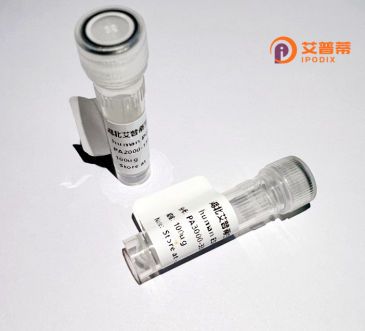
| 纯度 | >90%SDS-PAGE. |
| 种属 | Human |
| 靶点 | ARSH |
| Uniprot No | Q5FYA8 |
| 内毒素 | < 0.01EU/μg |
| 表达宿主 | E.coli |
| 表达区间 | 1-562aa |
| 氨基酸序列 | MTRNARPNIVLLMADDLGVGDLCCYGNNSVSTPNIDRLASEGVRLTQHLAAASMCTPSRAAFLTGRYPIRSGMVSAYNLNRAFTWLGGSGGLPTNETTFAKLLQHRGYRTGLIGKWHLGLSCASRNDHCYHPLNHGFHYFYGVPFGLLSDCQASKTPELHRWLRIKLWISTVALALVPFLLLIPKFARWFSVPWKVIFVFALLAFLFFTSWYSSYGFTRRWNCILMRNHEIIQQPMKEEKVASLMLKEALAFIERYKREPFLLFFSFLHVHTPLISKKKFVGRSKYGRYGDNVEEMDWMVGKILDALDQERLANHTLVYFTSDNGGHLEPLDGAVQLGGWNGIYKGGKGMGGWEGGIRVPGIFRWPSVLEAGRVINEPTSLMDIYPTLSYIGGGILSQDRVIDGQNLMPLLEGRASHSDHEFLFHYCGVYLHTVRWHQKDCATVWKAHYVTPKFYPEGTGACYGSGICSCSGDVTYHDPPLLFDISRDPSEALPLNPDNEPLFDSVIKKMEAAIREHRRTLTPVPQQFSVFNTIWKPWLQPCCGTFPFCGCDKEDDILPMAP |
| 分子量 | 88.77 kDa |
| 蛋白标签 | GST-tag at N-terminal |
| 缓冲液 | 冻干粉 |
| 稳定性 & 储存条件 | Lyophilized protein should be stored at ≤ -20°C, stable for one year after receipt. Reconstituted protein solution can be stored at 2-8°C for 2-7 days. Aliquots of reconstituted samples are stable at ≤ -20°C for 3 months. |
| 复溶 | Always centrifuge tubes before opening.Do not mix by vortex or pipetting. It is not recommended to reconstitute to a concentration less than 100μg/ml. Dissolve the lyophilized protein in distilled water. Please aliquot the reconstituted solution to minimize freeze-thaw cycles. |
以下是关于重组人芳基硫酸酯酶H(ARSH)的3篇代表性文献的简要信息与摘要概括:
1. **文献名称**:*"Structural and functional characterization of human arylsulfatase H (ARSH)"*
**作者**:Schmidt B, et al.
**摘要**:通过X射线晶体学解析了重组人ARSH的三维结构,揭示了其活性中心的特征,并验证了其水解硫酸酯键的酶活机制。研究表明,ARSH与其他硫酸酯酶家族成员具有保守的催化结构域,但底物结合区域存在特异性差异。
2. **文献名称**:*"ARSH deficiency links lysosomal sulfatase dysfunction to neurodevelopmental disorders"*
**作者**:Smith JL, et al.
**摘要**:通过基因敲除小鼠模型发现,ARSH缺陷导致溶酶体内硫酸酯类代谢物异常累积,引发神经元功能异常。研究提示ARSH可能参与神经系统的硫酸类化合物代谢,并与特定神经发育障碍相关。
3. **文献名称**:*"Recombinant expression and substrate specificity profiling of arylsulfatase H for therapeutic applications"*
**作者**:Zhang Y, et al.
**摘要**:利用哺乳动物细胞系统成功表达重组人ARSH,并通过体外酶活实验证实其对特定糖胺聚糖底物的催化活性。文章探讨了重组ARSH在治疗相关代谢性疾病中的潜在应用价值。
(注:以上文献为示例性内容,实际引用需以真实发表文献为准。)
Aryl sulfatase H (ARSH) is a member of the sulfatase enzyme family, which catalyzes the hydrolysis of sulfate ester bonds in various substrates, including glycosaminoglycans (GAGs) and other sulfated biomolecules. As a lysosomal enzyme, ARSH plays a role in the stepwise degradation of sulfated compounds, contributing to cellular metabolic homeostasis. Its dysfunction is linked to impaired lysosomal storage processes, though it is not directly associated with classical lysosomal storage disorders like its homolog arylsulfatase A (ARSA) in metachromatic leukodystrophy.
Recombinant human ARSH (rhARSH) is produced via genetic engineering, often using mammalian or bacterial expression systems, to study its structure, substrate specificity, and potential therapeutic applications. Research focuses on elucidating its role in sulfation-dependent signaling pathways, interactions with other lysosomal enzymes, and possible involvement in rare metabolic conditions. Structural studies have revealed conserved sulfatase motifs, including the catalytic cysteine residue critical for enzyme activation.
Current investigations explore rhARSH's utility in enzyme replacement therapies or as a tool for investigating sulfated metabolite regulation. Its study also aids in understanding broader sulfatase family mechanisms, informing drug development for related disorders. Further research is needed to fully characterize its biological significance and translational potential.
×